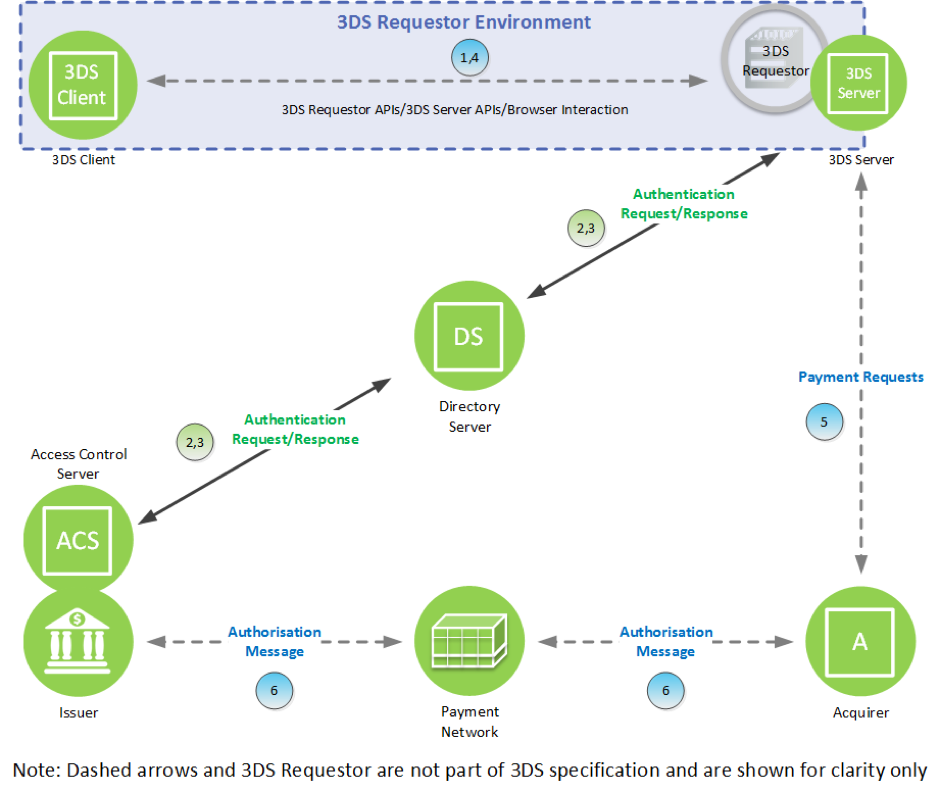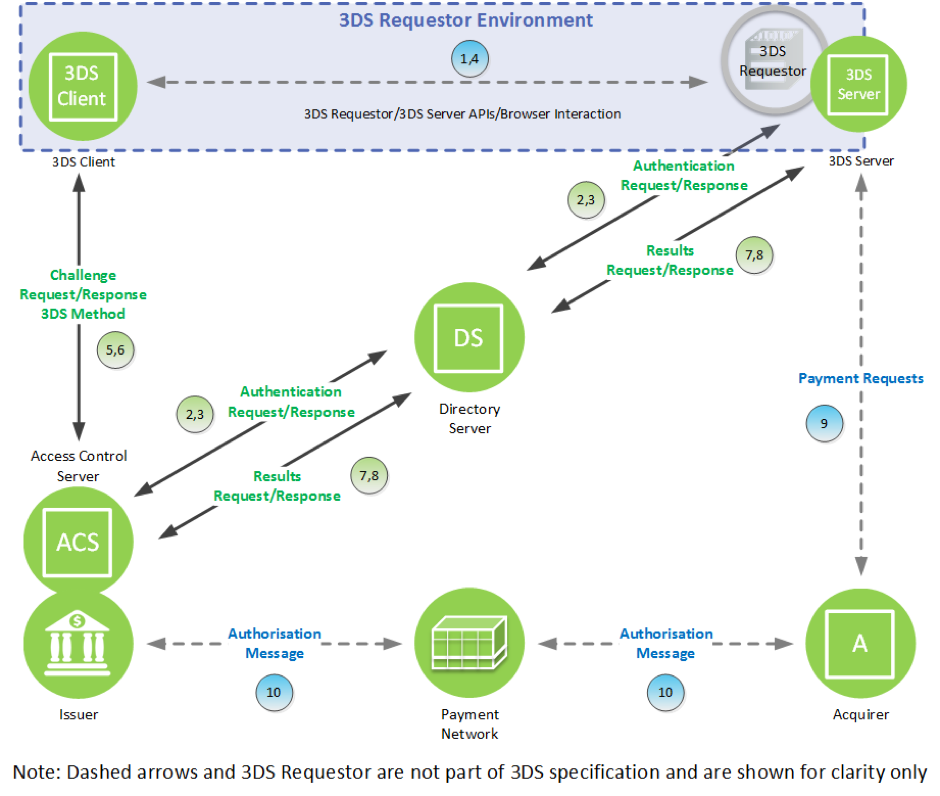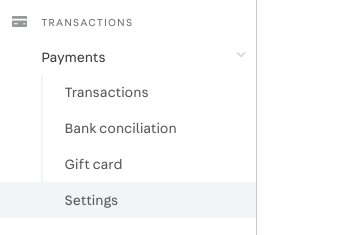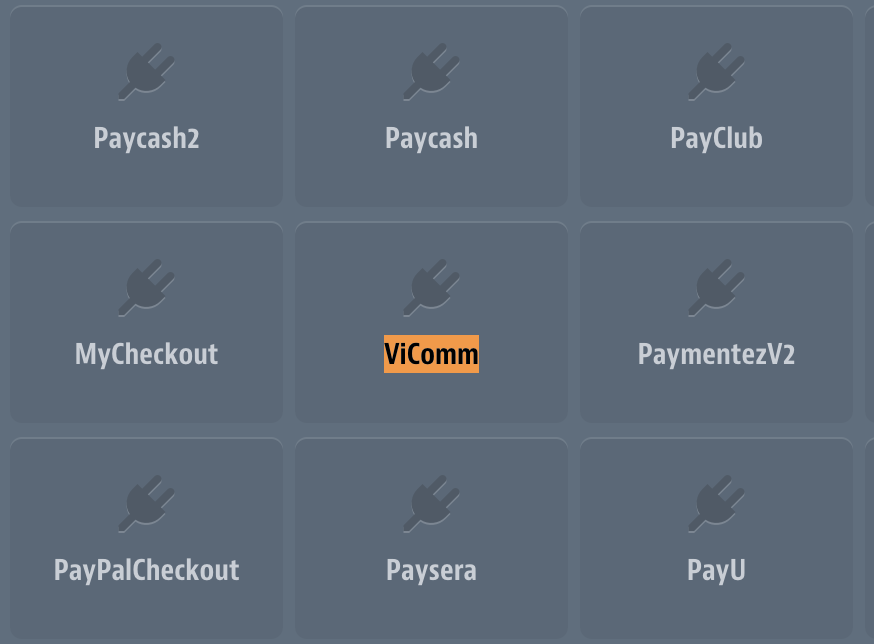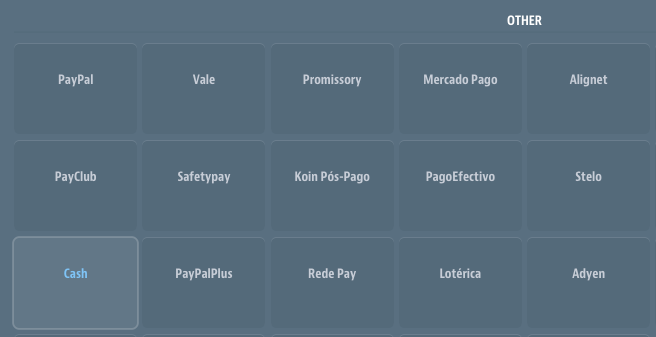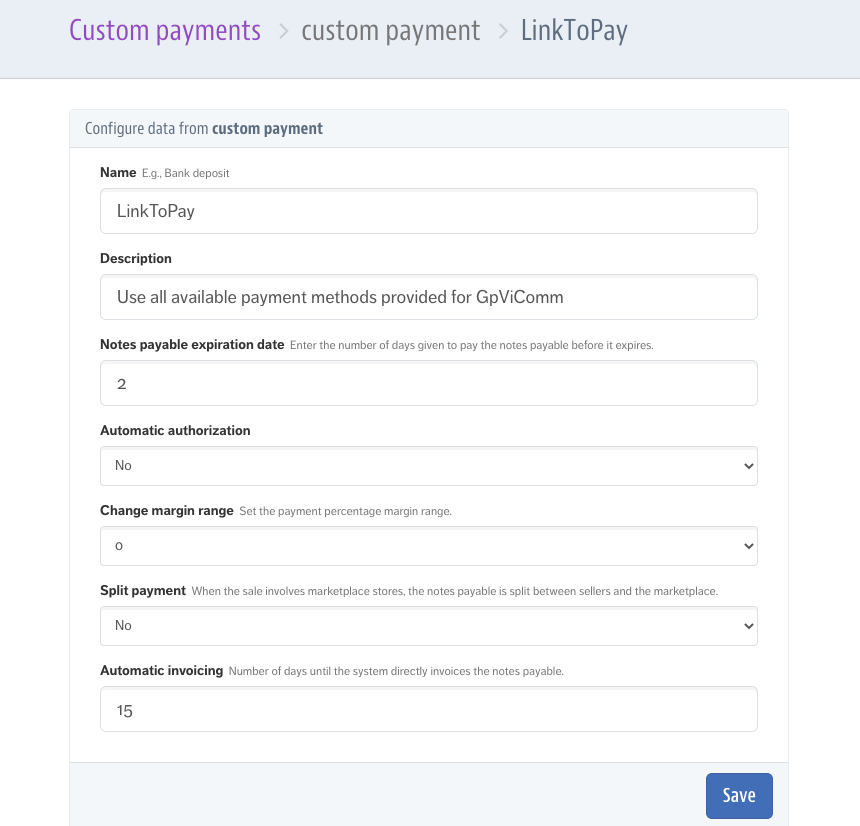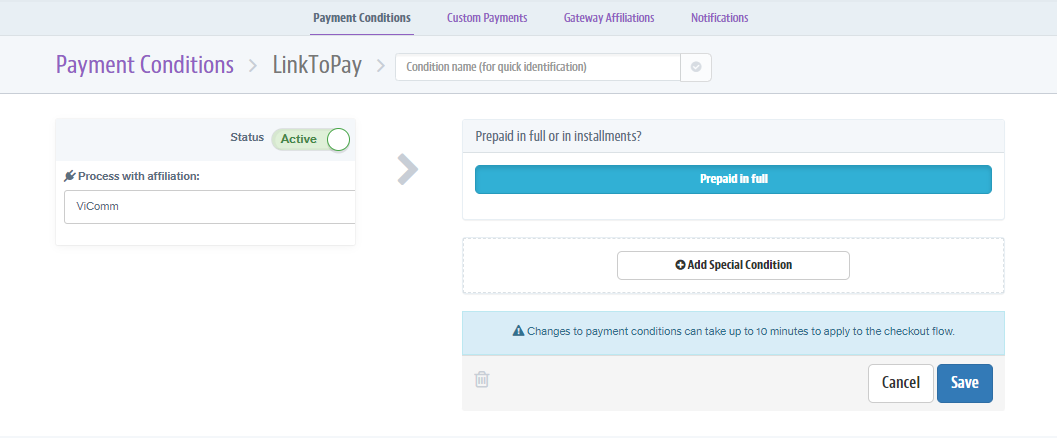La tokenización asegura que ningún dato
sensible de la tarjeta necesite estar en su servidor para que su
integración pueda operar de manera compatible con PCI. Si
alguna información de la tarjeta pasara por, o se
llegase a almacenar en su servidor, usted sería
responsable de cualquier penalidad o auditoría que
imponga PCI DSS.
Github Repository
GpViComm JS es una biblioteca que permite a los
desarrolladores conectar fácilmente con el API de
TARJETAS DE CRÉDITO de Global Payments ViComm.
Revise el ejemplo funcionando
Instalación
Primero necesitas incluir jQuery y los archivos
payment_stable.min.js y
payment_stable.min.css dentro de tu página
web especificando "UTF-8" como charset.
<script src="https://code.jquery.com/jquery-1.11.3.min.js" charset="UTF-8"></script>
<link href="https://cdn.gpvicomm.com/ccapi/sdk/payment_stable.min.css" rel="stylesheet" type="text/css" />
<script src="https://cdn.gpvicomm.com/ccapi/sdk/payment_stable.min.js" charset="UTF-8"></script>
Uso
Utilizando el Form de GpViComm
Cualquier elemento con la clase
payment-form será automáticamente
convertido en una entrada de tarjeta de crédito
básica con fecha de vencimiento y el check de CVC.
La manera más fácil de comenzar con GpViCommForm
es insertando el siguiente pedazo de código:
<div class="payment-form" id="my-card" data-capture-name="true"></div>
Para obtener el objeto Card de la instancia
PaymentForm, pregunte al formulario por su
tarjeta.
let myCard = $('#my-card');
let cardToSave = myCard.PaymentForm('card');
if(cardToSave == null){
alert("Invalid Card Data");
}
Si la tarjeta (Card) regresada es null, el estado
de error mostrará los campos que necesitan ser
arreglados.
Una vez que obtengas un objeto no null de la tarjeta
(Card) del widget, podrás llamar
addCard.
Biblioteca Init
Siempre debes inicializar la biblioteca.
/**
* Init library
*
* @param env_mode `prod`, `stg`, `local` para cambiar ambiente. Por defecto es `stg`
* @param client_app_code proporcionado por Global Payments ViComm.
* @param client_app_key proporcionado por Global Payments ViComm.
*/
Payment.init('stg', 'CLIENT_APP_CODE', 'CLIENT_APP_KEY');
addCard Agregar una Tarjeta
La función addCard convierte los datos confidenciales
de una tarjeta, en un token que puede pasar de forma segura a
su servidor, para realizar el cobro al usuario.
Esta funcionalidad consume el servicio de nuestro API pero de
manera segura para comercios que no cuentan con
certificación PCI.
Aquí
podras encontrar la descripción de cada campo en la
respuesta.
/*
* @param uid Identificador del usuario. Este es el id que usas del lado de tu aplicativo.
* @param email Email del usuario para iniciar la compra. Usar el formato válido para e-mail.
* @param card La tarjeta que se desea tokenizar.
* @param success_callback Funcionalidad a ejecutar cuando el servicio de la pasarela responde correctamente. (Incluso si se recibe un estado diferente a "valid")
* @param failure_callback Funcionalidad a ejecutar cuando el servicio de la pasarela responde con un error.
*/
Payment.addCard(uid, email, cardToSave, successHandler, errorHandler);
let successHandler = function(cardResponse) {
console.log(cardResponse.card);
if(cardResponse.card.status === 'valid'){
$('#messages').html('Tarjeta correctamente agregada<br>'+
'Estado: ' + cardResponse.card.status + '<br>' +
"Token: " + cardResponse.card.token + "<br>" +
"Referencia de transacción: " + cardResponse.card.transaction_reference
);
}else if(cardResponse.card.status === 'review'){
$('#messages').html('Tarjeta en revisión<br>'+
'Estado: ' + cardResponse.card.status + '<br>' +
"Token: " + cardResponse.card.token + "<br>" +
"Referencia de transacción: " + cardResponse.card.transaction_reference
);
}else if(cardResponse.card.status === 'pending'){
$('#messages').html('Tarjeta pendiente de aprobar<br>'+
'Estado: ' + cardResponse.card.status + '<br>' +
"Token: " + cardResponse.card.token + "<br>" +
"Referencia de transacción: " + cardResponse.card.transaction_reference
);
}else{
$('#messages').html('Error<br>'+
'Estado: ' + cardResponse.card.status + '<br>' +
"Mensaje: " + cardResponse.card.message + "<br>"
);
}
submitButton.removeAttr("disabled");
submitButton.text(submitInitialText);
};
let errorHandler = function(err) {
console.log(err.error);
$('#messages').html(err.error.type);
submitButton.removeAttr("disabled");
submitButton.text(submitInitialText);
};
El tercer argumento para el addCard es un objeto Card que
contiene los campos requeridos para realizar la
tokenización.
getSessionId
El Session ID es un parámetro que Global Payments
ViComm utiliza para fines del antifraude. Llame este
método si usted desea recolectar la información
del dispositivo del usuario.
let session_id = Payment.getSessionId();
Una vez que tenga el Session ID, puedes pasarlo a tu servidor
para realizar el cargo al usuario.
PaymentForm Referencia Completa
Inserción Manual
Si desea alterar manualmente los campos utilizados por
PaymentForm para añadir clases adicionales, el
placeholder o id. Puedes rellenar previamente los campos del
formulario como se muestra a continuación.
Esto podría ser útil en caso de que desees
procesar el formulario en otro idioma (de forma
predeterminada, el formulario se representa en
español), o para hacer referencia a alguna entrada por
nombre o id.
Por ejemplo si desea mostrar el formulario en Inglés y
añadir una clase personalizada para el
card_number
<div class="payment-form">
<input class="card-number my-custom-class" name="card-number" placeholder="Card number">
<input class="name" id="the-card-name-id" placeholder="Card Holders Name">
<input class="expiry-month" name="expiry-month">
<input class="expiry-year" name="expiry-year">
<input class="cvc" name="cvc">
</div>
Seleccionar Campos
Puedes determinar los campos que mostrará el
formulario.
| Field |
Description |
| data-capture-name |
Input para nombre del Tarjetahabiente, requerido para
tokenizar
|
| data-capture-email |
Input para email del usuario |
| data-capture-cellphone |
Input para teléfono celular del usuario
|
| data-icon-colour |
Color de los íconos |
| data-use-dropdowns |
Utiliza una lista desplegable para establecer la fecha
de expiración de la tarjeta
|
| data-exclusive-types |
Define los tipos de tarjetas permitidos
|
| data-invalid-card-type-message |
Define un mensaje personalizado para mostrar cuando se
registre una tarjeta no permitida
|
El campo 'data-use-dropdowns' puede resolver el problema que
se presenta con la mascara de expiración en
dispositivos móviles antiguos.
Se integra en el form de manera simple, como se muestra a
continuación:
<div class="payment-form"
id="my-card"
data-capture-name="true"
data-capture-email="true"
data-capture-cellphone="true"
data-icon-colour="#569B29"
data-use-dropdowns="true">
Tipos de tarjetas específicos
Si deseas especificar los tipos de tarjetas permitidos en el
formulario, como Exito o Alkosto. Puedes configurarlo como en
el siguiente ejemplo: Cuando una tarjeta de un tipo no
permitido es capturado, el formulario se reinicia, bloqueando
las entradas y mostrando un mensaje
Tipo de tarjeta invalida para está
operación.
<div class="payment-form"
id="my-card"
data-capture-name="true"
data-exclusive-types="ex,ak"
data-invalid-card-type-message="Tarjeta invalida. Por favor ingresa una tarjeta Exito / Alkosto."
>
Revisa todos los
tipos de tarjetas
permitidos por Global Payments ViComm.
Leyendo los Valores
PaymentForm proporciona funcionalidad que le permite leer los
valores del campo de formulario directamente con JavaScript.
Genera un elemento de PaymentForm y asigne un id único
(en este ejemplo my-card)
<div class="payment-form" id="my-card" data-capture-name="true"></div>
El siguiente javascript muestra cómo leer cada valor
del formulario en variables locales.
let myCard = $('#my-card');
let cardType = myCard.PaymentForm('cardType');
let name = myCard.PaymentForm('name');
let expiryMonth = myCard.PaymentForm('expiryMonth');
let expiryYear = myCard.PaymentForm('expiryYear');
let fiscalNumber = myCard.PaymentForm('fiscalNumber');
Funciones
Para llamar a una función en un elemento PaymentForm,
sigue el patrón a continuación. Remplace el
texto 'function' con el nombre de la función que desea
llamar.
$('#my-card').PaymentForm('function')
Las funciones disponibles se enumeran a continuación
| Function |
Description |
| card |
Obtiene la tarjeta del objeto |
| cardType |
Obtiene el tipo de tarjeta que se capturó
|
| name |
Obtiene el nombre capturado |
| expiryMonth |
Obtiene el mes de expiración de la tarjeta
|
| expiryYear |
Obtiene el año de expiración de la tarjeta
|
| fiscalNumber |
Obtiene el número fiscal del usuario /
cédula
|
Función CardType
La función cardType devolverá una
cadena según el número de tarjeta ingresado. Si
no se puede determinar el tipo de tarjeta, se le dará
una cadena vacía.
Marcas permitidas
Github Repository
Add it in your root build.gradle at the end of repositories:
allprojects {
repositories {
...
maven { url 'https://jitpack.io' }
}
}
Add this line to your app's build.gradle inside
the dependencies section:
implementation 'com.github.gpvicomm:gpvicomm-android:1.0'
ProGuard
If you're planning on optimizing your app with ProGuard, make
sure that you exclude the GpVicomm bindings. You can do this
by adding the following to your app's
proguard.cfg file:
-keep class com.gpvicomm.payment.** { *; }
Usage
Using the CardMultilineWidget
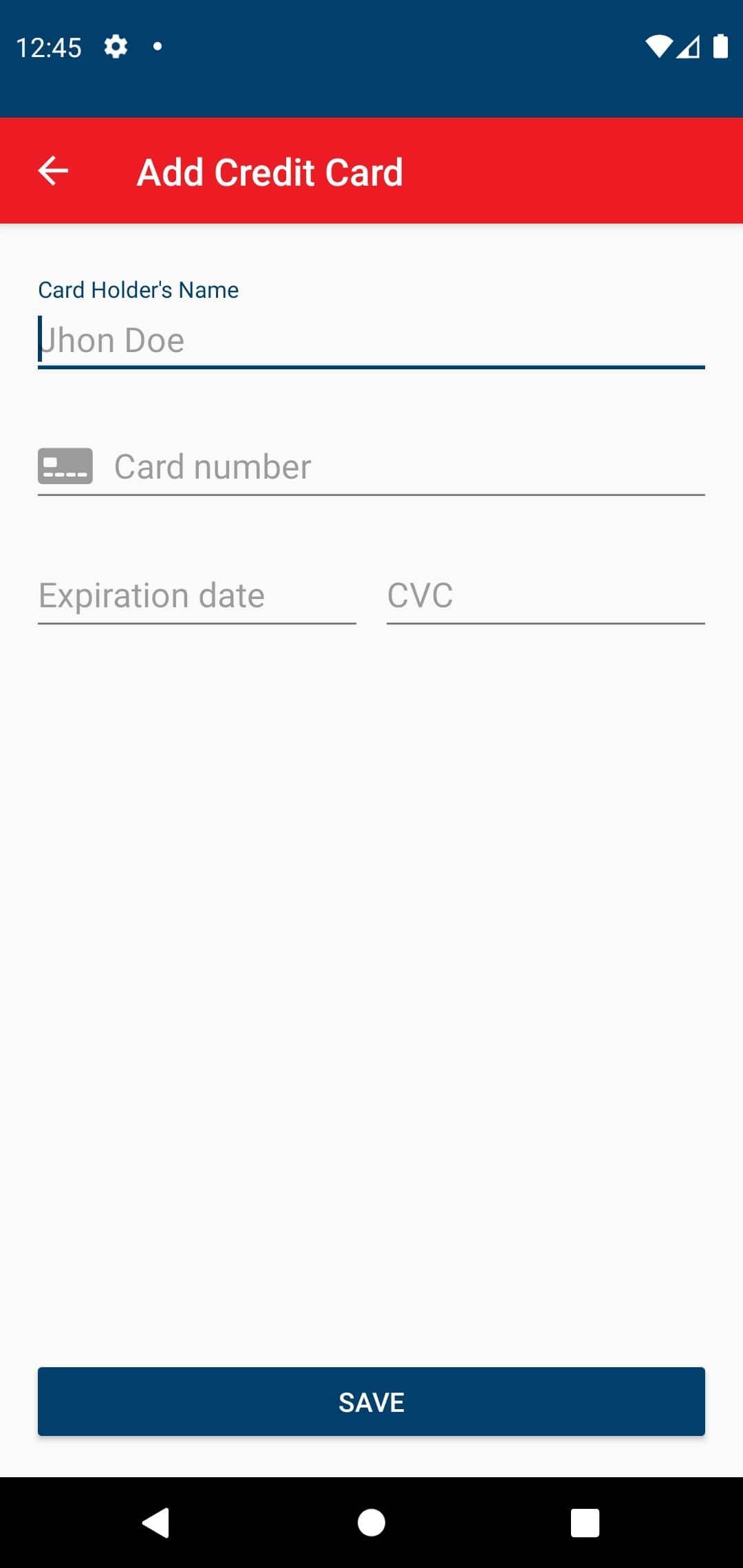
You can add a widget to your apps that easily handles the UI
states for collecting card data.
First, add the CardMultilineWidget to your layout.
<com.gpvicomm.payment.view.CardMultilineWidget android:id="@+id/card_multiline_widget"
android:layout_alignParentTop="true" android:layout_width="match_parent"
android:layout_height="wrap_content" />
You can customize the view with this tags:
app:shouldShowPostalCode="true"app:shouldShowLogo="true"app:shouldShowCardHolderName="true"app:shouldShowScanCard="true"
In order to use any of this tags, you'll need to enable the
app XML namespace somewhere in the layout.
xmlns:app="http://schemas.android.com/apk/res-auto"
To get a Card object from the
CardMultilineWidget, you ask the widget for its
card.
Card cardToSave=cardWidget.getCard();
if(cardToSave==null){
Alert.show(mContext,
"Error",
"Invalid Card Data");
return;
}
If the returned Card is null, error states will
show on the fields that need to be fixed.
Once you have a non-null Card object from the
widget, you can call addCard.
Init library
You should initialize the library on your Application or in
your first Activity.
import android.support.v7.app.ActionBarActivity;
import android.os.Bundle;
import android.view.Menu;
import android.view.MenuItem;
import com.gpvicomm.payment.Payment;
import com.gpvicomm.payment.demo.utils.Constants;
public class MainActivity extends ActionBarActivity {
@Override
protected void onCreate(Bundle savedInstanceState) {
super.onCreate(savedInstanceState);
setContentView(R.layout.activity_main);
/**
* Init library
*
* @param test_mode false to use production environment
* @param client_app_code provided by GpVicomm.
* @param client_app_key provided by GpVicomm.
*/
Payment.setEnvironment(Constants.IS_TEST_MODE, Constants.CLIENT_APP_CODE, Constants.CLIENT_APP_KEY);
// In case you have your own Fraud Risk Merchant Id
//Payment.setRiskMerchantId(1000);
// Note: for most of the devs, that's not necessary.
}
}
addCard
addCard converts sensitive card data to a single-use token
which you can safely pass to your server to charge the user.
Payment.addCard(mContext,uid,email,cardToSave,new TokenCallback(){
public void onSuccess(Card card){
if(card!=null){
if(card.getStatus().equals("valid")){
Alert.show(mContext,
"Card Successfully Added",
"status: "+card.getStatus()+"\n"+
"Card Token: "+card.getToken()+"\n"+
"transaction_reference: "+card.getTransactionReference());
}else if(card.getStatus().equals("review")){
Alert.show(mContext,
"Card Under Review",
"status: "+card.getStatus()+"\n"+
"Card Token: "+card.getToken()+"\n"+
"transaction_reference: "+card.getTransactionReference());
}else{
Alert.show(mContext,
"Error",
"status: "+card.getStatus()+"\n"+
"message: "+card.getMessage());
}
}
//TODO: Create charge or Save Token to your backend
}
public void onError(PaymentError error){
Alert.show(mContext,
"Error",
"Type: "+error.getType()+"\n"+
"Help: "+error.getHelp()+"\n"+
"Description: "+error.getDescription());
//TODO: Handle error
}
});
The first argument to addCard is mContext (Context).
- mContext. Context of the Current Activity
The second argument to addCard is uid (String).
-
uid Customer identifier. This is the identifier you use
inside your application; you will receive it in
notifications.
The third argument to addCard is email (String).
- email Email of the customer
The fourth argument to addCard is a Card object. A Card
contains the following fields:
-
number: card number as a string without any separators, e.g.
'4242424242424242'.
- holderName: cardholder name.
-
expMonth: integer representing the card's expiration month,
e.g. 12.
-
expYear: integer representing the card's expiration year,
e.g. 2013.
- cvc: card security code as a string, e.g. '123'.
- type:
The fifth argument tokenCallback is a callback you provide to
handle responses from GpVicomm. It should send the token to
your server for processing onSuccess, and notify the user
onError.
Here's a sample implementation of the token callback:
Payment.addCard(
mContext,uid,email,cardToSave,
new TokenCallback(){
public void onSuccess(Card card){
// Send token to your own web service
MyServer.chargeToken(card.getToken());
}
public void onError(PaymentError error){
Toast.makeText(getContext(),
error.getDescription(),
Toast.LENGTH_LONG).show();
}
}
);
addCard is an asynchronous call – it
returns immediately and invokes the callback on the UI thread
when it receives a response from GpVicomm's servers.
getSessionId
The Session ID is a parameter GpVicomm use for fraud purposes.
Call this method if you want to Collect your user's Device
Information.
String session_id=Payment.getSessionId(mContext);
Once you have the Session ID, you can pass it to your server
to charge the user.
Client-side validation helpers
The Card object allows you to validate user input before you
send the information to GpVicomm.
validateNumber
Checks that the number is formatted correctly and passes the
Luhn check.
validateExpiryDate
Checks whether or not the expiration date represents an actual
month in the future.
validateCVC
Checks whether or not the supplied number could be a valid
verification code.
validateCard
Convenience method to validate card number, expiry date and
CVC.
Getting started with the Android example app
Note: the app require an
Android SDK
and Gradle to build and run.
Building and Running the GpVicommStore
Before you can run the GpVicommStore application, you need to
provide it with your GpVicomm Credentials and a Sample
Backend.
-
If you don't have any Credentials yet, please ask your
contact on GpVicomm Team for it.
-
Head to https://github.com/gpvicomm/example-java-backend and
click "Deploy to Heroku" ( you may have to sign up for a
Heroku account as part of this process). Provide your
GpVicomm Server Credentials
SERVER_APP_CODE and
SERVER_APP_KEY fields under 'Env'. Click
"Deploy for Free".
- Open the project on Android Studio.
-
Replace the
CLIENT_APP_CODE and
CLIENT_APP_KEY constants in Constants.java with
your own GpVicomm Client Credentials.
-
Replace the
BACKEND_URL variable in the
Constants.java file with the app URL Heroku provides you
with (e.g. "https://my-example-app.herokuapp.com")
- Run the Project.
Important Note: if you only have one APP_CODE, please asume
that it's your SERVER_APP_CODE. So you need to
ask your contact on GpVicomm Team for your
CLIENT_APP_CODE.
===================
El SDK Android de pagos GpVicomm Global Payments es una
biblioteca que permite a los desarrolladores conectarse
fácilmente al API de tarjetas de Crédito de
GpVicomm.
Instalación
Android Studio (o Gradle)
Add it in your root build.gradle at the end of repositories:
allprojects {
repositories {
...
maven { url 'https://jitpack.io' }
}
}
Add this line to your app's build.gradle inside
the dependencies section:
implementation 'com.github.gpvicomm:gpvicomm-android:1.2.9'
ProGuard
Si usted está planeando optimiar su aplicación
con ProGuard, asegúrese de excluir los enlaces de
gpvicomm. Usted puede realizarlo añadiendo lo siguiente
al archivo proguard.cfg de su app:
-keep class com.gpvicomm.payment.** { *; }
Uso
Utilizando el CardMultilineWidget
Puede agregar un widget a sus aplicaciones que maneje
fácilmente los estados de la interfaz de usuario para
recopilar datos de la tarjeta.
Primero, añada el CardMultilineWidget a su layout.
<com.gpvicomm.payment.view.CardMultilineWidget android:id="@+id/card_multiline_widget"
android:layout_alignParentTop="true" android:layout_width="match_parent"
android:layout_height="wrap_content" />
Ustede puede personalizar la vista con las siguientes
etiquetas:
app:shouldShowPostalCode="true"app:shouldShowLogo="true"app:shouldShowCardHolderName="true"app:shouldShowScanCard="true"
Para usar cualquiera de estas etiquetas, deberá
habilitar el espacio de nombres XML de la aplicación en
algún lugar del layout.
xmlns:app="http://schemas.android.com/apk/res-auto"
Para obtener un objeto
Card delCardMultilineWidget, pidale
al widget su tarjeta.
Card cardToSave=cardWidget.getCard();
if(cardToSave==null){
Alert.show(mContext,
"Error",
"Invalid Card Data");
return;
}
Si la Card devuelta es null , se mostrarán
estados de error en los campos que deben corregirse.
Una vez que tenga un objeto Card no null
regresado desde el widget, puede llamar a
addCard.
Inicializar Biblioteca
Usted debe inicializar la biblioteca en su Aplicación
en su primera actividad. You should initialize the library on
your Application or in your first Activity.
import android.support.v7.app.ActionBarActivity;
import android.os.Bundle;
import android.view.Menu;
import android.view.MenuItem;
import com.gpvicomm.payment.Payment;
import com.gpvicomm.payment.demo.utils.Constants;
public class MainActivity extends ActionBarActivity {
@Override
protected void onCreate(Bundle savedInstanceState) {
super.onCreate(savedInstanceState);
setContentView(R.layout.activity_main);
/**
* Init library
*
* @param test_mode false to use production environment
* @param client_app_code provided by gpvicomm.
* @param client_app_key provided by gpvicomm.
*/
Payment.setEnvironment(Constants.IS_TEST_MODE, Constants.CLIENT_APP_CODE, Constants.CLIENT_APP_KEY);
// In case you have your own Fraud Risk Merchant Id
//Payment.setRiskMerchantId(1000);
// Note: for most of the devs, that's not necessary.
}
}
addCard
addCard convierte datos confidenciales de la tarjeta en un
token de un solo uso que puede pasar de forma segura a su
servidor para realizar el cobro al usuario.
Payment.addCard(mContext,uid,email,cardToSave,new TokenCallback(){
public void onSuccess(Card card){
if(card!=null){
if(card.getStatus().equals("valid")){
Alert.show(mContext,
"Card Successfully Added",
"status: "+card.getStatus()+"\n"+
"Card Token: "+card.getToken()+"\n"+
"transaction_reference: "+card.getTransactionReference());
}else if(card.getStatus().equals("review")){
Alert.show(mContext,
"Card Under Review",
"status: "+card.getStatus()+"\n"+
"Card Token: "+card.getToken()+"\n"+
"transaction_reference: "+card.getTransactionReference());
}else{
Alert.show(mContext,
"Error",
"status: "+card.getStatus()+"\n"+
"message: "+card.getMessage());
}
}
//TODO: Create charge or Save Token to your backend
}
public void onError(PaymentError error){
Alert.show(mContext,
"Error",
"Type: "+error.getType()+"\n"+
"Help: "+error.getHelp()+"\n"+
"Description: "+error.getDescription());
//TODO: Handle error
}
});
El primer argumento del addCard es mContext (Context).
- mContext. Context de la Actividad actual.
El segundo argumento del addCard es uid (Cadena).
-
uid Identificador de comprador. Este es el identificador que
usa dentro de su aplicación; lo recibirá en
las notificaciones.
El tercer argumento del addCard es el email (Cadena).
- email Email del comprador
El cuarto argumento del addCard es un objeto de tipo Card. Un
objeto Card contiene los siguientes campos:
-
number: número de tarjeta como cadena sin
ningún separador, por ejemplo '4242424242424242'.
- holderName: nombre del tarjehabiente.
-
expMonth: entero que representa el mes de expiración
de la tarjeta, por ejemplo 12.
-
expYear: entero que represetna el año de
expiración de la tarjeta, por ejemplo 2019.
-
cvc: código de seguridad de la tarjeta, como cadena,
por ejemplo '123'.
- type: el tipo de tarjeta.
El quinto argumento tokenCallBack es un callback que usted
provee para manejar las respuestas recibidas de gpvicomm.
The fifth argument tokenCallback is a callback you provide to
handle responses from gpvicomm. Deberá enviar el token
a su servidor para procesar onSuccess y notificar al usuario
onError.
Aquí se muestra un ejemplo de implementación de
callback del token:
Payment.addCard(
mContext,uid,email,cardToSave,
new TokenCallback(){
public void onSuccess(Card card){
// Send token to your own web service
MyServer.chargeToken(card.getToken());
}
public void onError(PaymentError error){
Toast.makeText(getContext(),
error.getDescription(),
Toast.LENGTH_LONG).show();
}
}
);
addCard es una llamada asíncrona - regresa
inmediatamente e invoca el callback en el hilo de la interfaz,
cuando recibe una respuesta de los servidores de gpvicomm.
getSessionId
El Session ID es un parámetro que gpvicomm utiliza para
fines de antifraude. Llave esté método cuando
quiera recabar la información del dispositivo.
String session_id=Payment.getSessionId(mContext);
Una vez que tenga el Session ID, usted podrá pasarlo a
su servidor para realizar el cobro a su usuario.
Herramientas de validación del lado del Cliente
El objeto Card permite validar la información capturada
por el usuario antes de enviarla a gpvicomm.
validateNumber
Verifica que el número tenga el formato correcto y pase
el algoritmo de
Luhn.
validateExpiryDate
Comprueba que la fecha de expiración representa una
fecha real futura.
validateCVC
Comprueba si el número proporcionado podría ser
un código de verificación válido o no.
validateCard
Método que valida el número de tarjeta, la fecha
de expiración y el CVC.
Introducción a la aplicación de ejemplo de
Android
Nota: la aplicación requiere
Android SDK
y Gradle para coinstruir y
ejecutar.
Construyendo y Ejecutando la PaymentStore
Antes de que pueda pueda correr la aplicación
PaymentStore, ested necesita proveerla con las credenciales de
gpvicomm y un backend de muestra.
-
Si aún no cuenta con credenciales, pídalas a
su contancto en el equipo de gpvicomm.
-
Dirígase a
https://github.com/gpvicomm/example-java-backend y haga
click en "Deploy to Heroku" (es posible que tengas que
registrarte para obtener una cuenta de Heroku como parte de
este proceso). Proporcione sus credenciales de servidor de
gpvicomm
SERVER_APP_CODE y
SERVER_APP_KEYen los campos "Env". Haga click
en "Deploy for Free".
- Abra el proyecto en Android Studio.
-
Reemplace las constantes
CLIENT_APP_CODE y
CLIENT_APP_KEY en Constants.java con sus
propias credenciales de gpvicomm.
-
Reemplace la variable
BACKEND_URL en el archivo
Constants.java con la URL de la aplicación que Heroku
le proporciona (por ejemplo,"
https://my-example-app.herokuapp.com ")
- Ejecute el proyecto.
Nota importante: si solo tiene un APP_CODE, suponga que es su
SERVER_APP_CODE. Por lo tanto, debe solicitar a
su contacto en el equipo de gpvicomm su
CLIENT_APP_CODE.
Github Repository
Requirements
Version <= 1.4.x - iOS 9.0 or Later - Xcode 9
Version >= 1.5.x - iOS 9.0 or Later - Xcode 10
Framework Dependencies:
Accelerate AudioToolbox AVFoundation CoreGraphics CoreMedia
CoreVideo Foundation MobileCoreServices OpenGLES QuartzCore
Security UIKit CommonCrypto (Just for version 1.4)
Project Configuration - ObjC in other linker
flags in target - lc++ in target other linker flags - Disable
Bitcode
INSTALLATION
Carthage
If you haven't already, install the latest version of
Carthage
Add this to the Cartfile:
git "https://github.com/gpvicomm/gpvicomm-ios"
For Beta Versions:
git "https://github.com/agpvicomm/gpvicomm-ios"
"master"
ObjC configuration
Set ALWAYS_EMBED_SWIFT_STANDARD_LIBRARIES = YES
In Build Phases -> Embed Frameworks Uncheck "Copy Only When
Installing"
Manual Installation(Recommended)
SDK is a dynamic framework (More Info) so you have to build each version for the desire target
(simulator and device). To make the integration easy, you can
follow these instructions in order to have just one Universal
.framework file.
- Build the SDK and create .framework files
This will create a /build folder where there are all the
necesary .framework (simulator, iphoneos and universal)
-
With Target PaymentSDK selected, build the project for any
iOS Simulator.
-
With Target PaymentSDK selected, build the project for a
physical device.
After
-
With the Target PaymentSDK-Universal, build the project for
any iOS device.
-
Inside the group Products -> PaymentSDK.framework ->
Show in finder
-
Inside the the directory of PaymentSDK.framework, CMD+up
-
You can see three groups, inside the group
Release-iosuniversal, you'll find the PaymentSDK.framework
-
Or if you prefer you can download pre-compilled .framework
files from
Releases
-
Drag the PaymentSDK.framework To your project and check
"Copy Files if needed".
In Target->General : Add PaymentSDK.framework to
Frameworks, Libraries, and Embedded Content
In Target->Build Settings : Validate Workspace should be
YES
- Update the Build Settings with
Set ALWAYS_EMBED_SWIFT_STANDARD_LIBRARIES = YES
In Build Phases -> Embed Frameworks Uncheck "Copy Only When
Installing"
-
If you use the Universal version and you want to upload to
the appstore. Add Run Script Phase: Target->Build Phases
-> + ->New Run Script Phase. And paste the following.
Make sure that this build phase is added after Embed
Frameworks phase.
bash "${BUILT_PRODUCTS_DIR}/${FRAMEWORKS_FOLDER_PATH}/PaymentSDK.framework/install_dynamic.sh"
Usage
Importing Swift
import PaymentSDK
Setting up your app inside
AppDelegate->didFinishLaunchingWithOptions. You should use
the Payment Client Credentials (Just ADD enabled)
PaymentSDKClient.setEnvironment("AbiColApp", secretKey:
"2PmoFfjZJzjKTnuSYCFySMfHlOIBz7", testMode: true)
Types of implementation
There are 3 ways to present the Add Card Form:
- As a Widget in a Custom View
-
As a Viewcontroller Pushed to your UINavigationController
- As a ViewController presented in Modal
The AddCard Form includes: Card io scan, and card validation.
Show AddCard Widget
In order to create a widget you should create a
PaymentAddNativeController from the PaymentSDKClient. Then add
it to the UIView that will be the container of the Payment
Form. The min height should be 300 px, and whole screen as
width (270px without payment logo)
Note:
When you are using the Payment Form as Widget. The Client
custom ViewController will be responsible for the layout and
synchronization (aka Spinner or loading)
The widget can scan with your phones camera the credit card
data using card.io.
let paymentAddVC = self.addPaymentWidget(toView: self.addView, delegate: nil, uid:UserModel.uid, email:UserModel.email)
Objc
[self addPaymentWidgetToView:self. addView delegate:self uid:@"myuid" email:@"myemail"];
Retrive the valid credit card from the
PaymentAddNativeController (Widget):
if let validCard = paymentAddVC.getValidCard() // CHECK IF THE CARD IS VALID, IF THERE IS A VALIDATION ERROR NIL VALUE WILL BE RETURNED
{
sender?.isEnabled = false
PaymentSDKClient.createToken(validCard, uid: UserModel.uid, email: UserModel.email, callback: { (error, cardAdded) in
if cardAdded != nil // handle the card status
{
}
else if error != nil //handle the error
{
}
})
}
Objc
PaymentCard *validCard = [self.paymentAddVC getValidCard];
if (validCard != nil) // Check if it is avalid card
{
[PaymentSDKClient add:validCard uid:USERMODEL_UID email:USERMODEL_EMAIL callback:^(PaymentSDKError *error, PaymentCard *cardAdded) {
[sender setEnabled:YES];
if(cardAdded != nil) // handle the card status
{
}
else //handle the error
{
}
}];
}
Pushed to your NavigationController
self.navigationController?.pushPaymentViewController(delegate: self, uid: UserModel.uid, email: UserModel.email)
Objc
[self.navigationController pushPaymentViewControllerWithDelegate:self uid:@"myuid" email:@"mymail@mail.com"]`;
Present as Modal
self.presentPaymentViewController(delegate: self, uid: "myuid", email: "myemail@email.com")
Objc
[self presentPaymentViewControllerWithDelegate:self uid:@"myuid" email:@"myemail@email.com"];
PaymentCardAddedDelegate Protocol
If you present the Form as a viewcontroller (push and modal)
you must implement the PaymentCardAddedDelegate Protocol in
order to handle the states or actions inside the
Viewcontroller. If you are using Widget implementation you can
handle the actions as described above.
protocol PaymentCardAddedDelegate
{
func cardAdded(_ error:PaymentSDKError?, _ cardAdded:PaymentCard?)
func viewClosed()
}
func cardAdded(_ error:PaymentSDKError?, _
cardAdded:PaymentCard?)
is called whenever there is an error or a card is added.
func viewClosed() Whenever the modal is closed
Scan Card
If you want to do the scan yourself, using card.io
PaymentSDKClient.scanCard(self) { (closed, number, expiry, cvv, card) in
if !closed // user did not closed the scan card dialog
{
if card != nil // paymentcard object to handle the data
{
}
})
-ObjC
[PaymentSDKClient scanCard:self callback:^(BOOL userClosed, NSString *cardNumber, NSString *expiryDate, NSString *cvv, PaymentCard *card) {
if (!userClosed) //user did not close the scan card dialog
{
if (card != nil) // Handle card
{
}
}
}];
Add Card (Only PCI Integrations)
For custom form integrations Fields required + cardNumber:
card number as a string without any separators, e.g.
4111111111111111. + cardHolder: cardholder name. +
expuryMonth: integer representing the card's expiration month,
01-12. + expiryYear: integer representing the card's
expiration year, e.g. 2020. + cvc: card security code as a
string, e.g. '123'.
let card = PaymentCard.createCard(cardHolder:"Gustavo Sotelo", cardNumber:"4111111111111111", expiryMonth:10, expiryYear:2020, cvc:"123")
if card != nil // A valid card was created
{
PaymentSDKClient.add(card, uid: "69123", email: "dev@gpvicomm.mx", callback: { (error, cardAdded) in
if cardAdded != nil
{
//the request was succesfully sent, you should check the cardAdded status
}
})
}
else
{
//handle invalid card
}
ObjC
PaymentCard *validCard = [PaymentCard createCardWithCardHolder:@"Gustavo Sotelo" cardNumber:@"4111111111111111" expiryMonth:10 expiryYear:2020 cvc:@"123"];
if (validCard != nil) // Check if it is avalid card
{
[PaymentSDKClient add:validCard uid:USERMODEL_UID email:USERMODEL_EMAIL callback:^(PaymentSDKError *error, PaymentCard *cardAdded) {
[sender setEnabled:YES];
if(cardAdded != nil) // handle the card status
{
}
else //handle the error
{
}
}];
}
Secure Session Id
Debit actions should be implemented in your own backend. For
security reasons we provide a secure session id generation,
for kount fraud systems. This will collect the device
information in background
let sessionId = PaymentSDKClient.getSecureSessionId()
Objc
NSString *sessionId = [PaymentSDKClient getSecureSessionId];
Utils
Get Card Assets
let card = PaymentCard.createCard(cardHolder:"Gustavo Sotelo", cardNumber:"4111111111111111", expiryMonth:10, expiryYear:2020, cvc:"123")
if card != nil // A valid card was created
{
let image = card.getCardTypeAsset()
}
Get Card Type (Just Amex, Mastercard, Visa, Diners)
let card = PaymentCard.createCard(cardHolder:"Gustavo Sotelo", cardNumber:"4111111111111111", expiryMonth:10, expiryYear:2020, cvc:"123")
if card != nil // A valid card was created
{
switch(card.cardType)
{
case .amex:
case .masterCard:
case .visa:
case .diners:
default:
//not supported action
}
}
Customize Look & Feel
You can customize widget colors sample
paymentAddVC.baseFontColor = .white
paymentAddVC.baseColor = .green
paymentAddVC.backgroundColor = .white
paymentAddVC.showLogo = false
paymentAddVC.baseFont = UIFont(name: "Your Font", size: 12) ?? UIFont.systemFont(ofSize: 12)
The customizable elements of the form are the following:
-
baseFontColor : The color of the font of the
fields
-
baseColor: Color of the lines and titles of the
fields
-
backgroundColor: Background color of the widget
showLogo: Enable or disable Payment LogobaseFont: Font of the entire form-
nameTitle: String for the custom placeholder
for the Name Field
-
cardTitle: String for the custom placeholder
for the Card Field
-
invalidCardTitle String for the error message
when a card number is invalid
Building and Running the PaymentSwift
Before you can run the PaymentStore application, you need to
provide it with your APP_CODE, APP_SECRET_KEY and a sample
backend.
-
If you haven't already and APP_CODE and APP_SECRET_KEY,
please ask your contact on Payment Team for it.
-
Replace the
PAYMENT_APP_CODE and
PAYMENT_APP_SECRET_KEY in your AppDelegate as
shown in Usage section
-
Head to https://github.com/gpvicomm/example-java-backend and
click "Deploy to Heroku" (you may have to sign up for a
Heroku account as part of this process). Provide your
Payment Server Credentials APP_CODE and APP_SECRET_KEY
fields under 'Env'. Click "Deploy for Free".
-
Replace the
BACKEND_URL variable in the
MyBackendLib.swift (inside the variable myBackendUrl) with
the app URL Heroku provides you with (e.g.
"https://my-example-app.herokuapp.com")
-
Replace the variables (uid and email) in UserModel.swift
with your own user id reference

